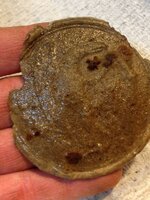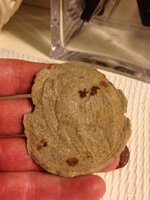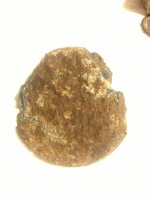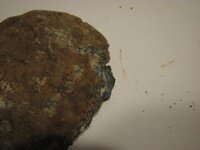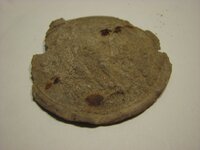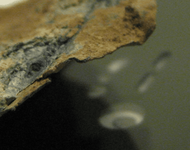zaxfire69
Bronze Member
- Jun 26, 2008
- 1,611
- 404
- Detector(s) used
- Fisher F75 / Fisher F44
- Primary Interest:
- All Treasure Hunting
Hello everyone on T-Net!! I haven't posted in awhile, because I haven't had much to show lately UNTIL today!!! . Well today was a day I won't forget for along time. Started out digging Flat buttons. Lord I was in heaven. Signals. Haven't heard those sounds in awhile. Well the Highlight of the day was a screamer. 90 on ATPro. Dug my plug and nails were coming out of the hole. I rescanned and still a high screamer. Dug down and found a round dull looking disk. I could see the Wing of the breastplate!!! Boy did I let out a rebel yell! I was excited. The only thing that threw me off was the way the metal looked. It looked like old pewter. Not Brass like most Breastplates. Got it home and cleaned it up and out popped the Eagle. It looked different than most I have seen on the internet. Still trying to find one, but I haven't found one exactly like it yet. Hopefully Quindy or anyone can chime in and help me out. Well after the Breastplate signals got slim and I ended up changing sites and found a General service Eagle button and a couple of cool Heel plates. Man I sure hope you guys can help me narrow this find down. I am still on Cloud nine. I hope you all enjoy my pictures from today. Missed you all on T-net!!
. Well today was a day I won't forget for along time. Started out digging Flat buttons. Lord I was in heaven. Signals. Haven't heard those sounds in awhile. Well the Highlight of the day was a screamer. 90 on ATPro. Dug my plug and nails were coming out of the hole. I rescanned and still a high screamer. Dug down and found a round dull looking disk. I could see the Wing of the breastplate!!! Boy did I let out a rebel yell! I was excited. The only thing that threw me off was the way the metal looked. It looked like old pewter. Not Brass like most Breastplates. Got it home and cleaned it up and out popped the Eagle. It looked different than most I have seen on the internet. Still trying to find one, but I haven't found one exactly like it yet. Hopefully Quindy or anyone can chime in and help me out. Well after the Breastplate signals got slim and I ended up changing sites and found a General service Eagle button and a couple of cool Heel plates. Man I sure hope you guys can help me narrow this find down. I am still on Cloud nine. I hope you all enjoy my pictures from today. Missed you all on T-net!! But I am back...Zaxfire69
But I am back...Zaxfire69





 . Well today was a day I won't forget for along time. Started out digging Flat buttons. Lord I was in heaven. Signals. Haven't heard those sounds in awhile. Well the Highlight of the day was a screamer. 90 on ATPro. Dug my plug and nails were coming out of the hole. I rescanned and still a high screamer. Dug down and found a round dull looking disk. I could see the Wing of the breastplate!!! Boy did I let out a rebel yell! I was excited. The only thing that threw me off was the way the metal looked. It looked like old pewter. Not Brass like most Breastplates. Got it home and cleaned it up and out popped the Eagle. It looked different than most I have seen on the internet. Still trying to find one, but I haven't found one exactly like it yet. Hopefully Quindy or anyone can chime in and help me out. Well after the Breastplate signals got slim and I ended up changing sites and found a General service Eagle button and a couple of cool Heel plates. Man I sure hope you guys can help me narrow this find down. I am still on Cloud nine. I hope you all enjoy my pictures from today. Missed you all on T-net!!
. Well today was a day I won't forget for along time. Started out digging Flat buttons. Lord I was in heaven. Signals. Haven't heard those sounds in awhile. Well the Highlight of the day was a screamer. 90 on ATPro. Dug my plug and nails were coming out of the hole. I rescanned and still a high screamer. Dug down and found a round dull looking disk. I could see the Wing of the breastplate!!! Boy did I let out a rebel yell! I was excited. The only thing that threw me off was the way the metal looked. It looked like old pewter. Not Brass like most Breastplates. Got it home and cleaned it up and out popped the Eagle. It looked different than most I have seen on the internet. Still trying to find one, but I haven't found one exactly like it yet. Hopefully Quindy or anyone can chime in and help me out. Well after the Breastplate signals got slim and I ended up changing sites and found a General service Eagle button and a couple of cool Heel plates. Man I sure hope you guys can help me narrow this find down. I am still on Cloud nine. I hope you all enjoy my pictures from today. Missed you all on T-net!! But I am back...Zaxfire69
But I am back...Zaxfire69




Last edited:
Upvote
16



